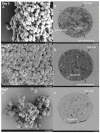Simultaneous Removal of the Freshwater Bloom-Forming Cyanobacterium Microcystis and Cyanotoxin Microcystins via Combined Use of Algicidal Bacterial Filtrate and the Microcystin-Degrading Enzymatic Agent, MlrA
- PMID: 34442673
- PMCID: PMC8401626
- DOI: 10.3390/microorganisms9081594
Simultaneous Removal of the Freshwater Bloom-Forming Cyanobacterium Microcystis and Cyanotoxin Microcystins via Combined Use of Algicidal Bacterial Filtrate and the Microcystin-Degrading Enzymatic Agent, MlrA
Abstract
Freshwater cyanobacterial blooms (e.g., Microcystis blooms) constitute a major global environmental problem because of their risks to public health and aquatic ecological systems. Current physicochemical treatments of toxic cyanobacteria cause the significant release of cyanotoxin microcystins from damaged cells. Biological control is a promising eco-friendly technology to manage harmful cyanobacteria and cyanotoxins. Here, we demonstrated an efficient biological control strategy at the laboratory scale to simultaneously remove Microcystis and microcystins via the combined use of the algicidal bacterial filtrate and the microcystin-degrading enzymatic agent. The algicidal indigenous bacterium Paenibacillus sp. SJ-73 was isolated from the sediment of northern Lake Taihu, China, and the microcystin-degrading enzymatic agent (MlrA) was prepared via the heterologous expression of the mlrA gene in the indigenous microcystin-degrading bacterium Sphingopyxis sp. HW isolated from Lake Taihu. The single use of a fermentation filtrate (5%, v/v) of Paenibacillus sp. SJ-73 for seven days removed the unicellular Microcystis aeruginosa PCC 7806 and the native colonial Microcystis strain TH1701 in Lake Taihu by 84% and 92%, respectively, whereas the single use of MlrA removed 85% of microcystins. Used in combination, the fermentation filtrate and MlrA removed Microcystis TH1701 and microcystins by 92% and 79%, respectively. The present biological control thus provides an important technical basis for the further development of safe, efficient, and effective measures to manage Microcystis blooms and microcystins in natural waterbodies.
Keywords: Microcystis blooms; MlrA enzyme; algicidal bacteria; biological removal; microcystin release.
Conflict of interest statement
The authors declare no conflict of interest.
Figures







References
-
- Smith J.L., Boyer G.L., Zimba P.V. A review of cyanobacterial odorous and bioactive metabolites: Impacts and management alternatives in aquaculture. Aquaculture. 2008;280:5–20. doi: 10.1016/j.aquaculture.2008.05.007. - DOI
Grants and funding
LinkOut - more resources
Full Text Sources

